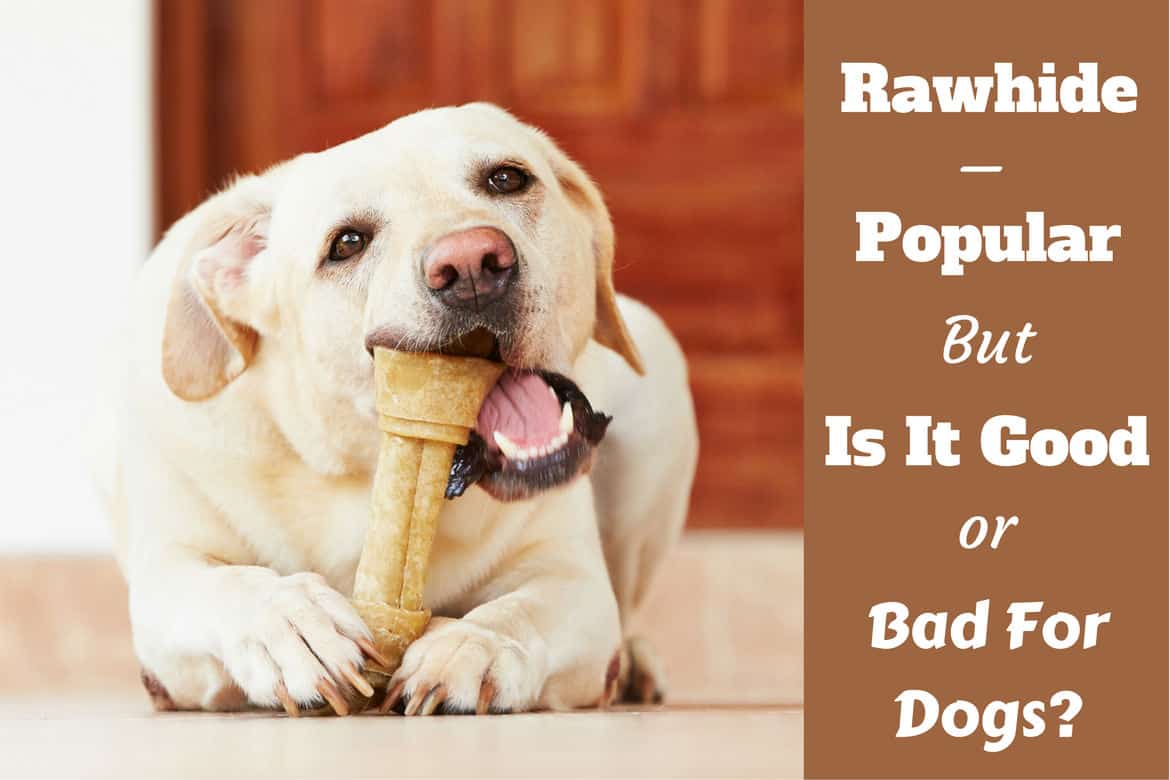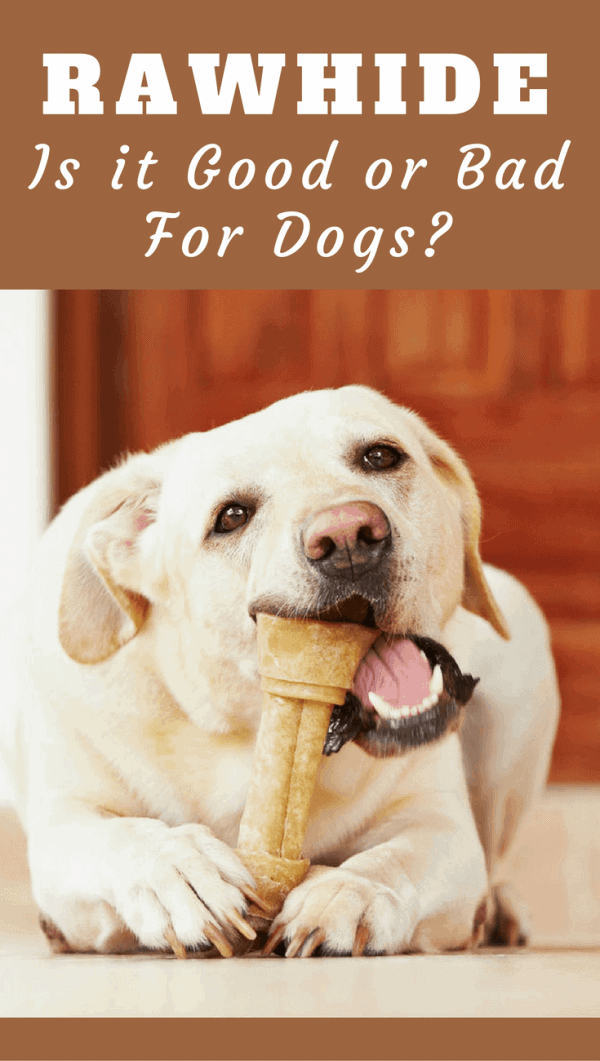This post may contain affiliate links. We may earn money or products from the companies mentioned in this post.

Many dogs and puppies love nothing more than to get their jaws around a chunk of tasty rawhide for hours of occupational chewing.
But, is rawhide bad for dogs? Or is it perfectly safe and even good for them?
Well, there are both benefits and risks associated with dogs chewing rawhide – which we’ll discuss in the article below.
What is Rawhide Made of? Why do Dogs Love it?
Rawhide is an animal product extracted from the inner layer of a horse, pig or cowhide, that is stripped of all hair and residue before being dried and packaged up for sale in pet shops as dog chews.
Many dogs love rawhide as it satisfies their urge to chew, right from their teething stage as a puppy through to their adult years.
Chewing helps to relieve boredom and curb anxiety, and many owners understandably prefer their pups to chew on rawhide rather than their belongings!
Some rawhide manufacturers add special flavorings to their recipes to make them even more appealing.
While most are relatively standard, like liver, beef and chicken, some go a little further with nutty flavors such as bubblegum.
What are the Benefits of Rawhide for Dogs?
Aside from loving the taste of rawhide, the product can be a valuable extra to your dog’s diet.
During their teething phase, puppies will love rawhide as it relieves the gum discomfort and helps them develop strong, flexible jaws. As a bonus for you, it will stop your puppy chewing up your furniture!
It’s also a suitable product to help keep your dog’s teeth clean and healthy, whatever their age.
The hard texture of the rawhide will scrub against their teeth, helping to remove any plaque or tartar and will keep their breath fresh.
Or Is Rawhide Safe for Dogs? Are There any Risks?
Unfortunately, many risks come with rawhide that you should be aware of if you’re considering giving it to your dog.
On an entirely practical level, rawhide can be a choking hazard – if a piece breaks off or if your dog chews it down to a small enough size, it could be accidentally swallowed and choked on.
Also, some dogs are sensitive to the composition of rawhide, and it can cause problems like diarrhea, vomiting, lethargy and weight loss.
Furthermore, if manufactured outside of the US where there is less regulation, rawhide has been found to be contaminated with nasty chemicals, like arsenic and formaldehyde.
After it’s been extracted from the animal hide, the rawhide may undergo a toxic sodium sulfide liming procedure to rid it of hair that exposes it to various toxins.
Additionally, rawhide manufactured abroad may be doused in extra chemicals to preserve the product during the shipping and transportation process.
Some imported rawhide has even been found to contain the skins of dogs inhumanely slaughtered in Thailand, according to a 1998 report by Humane Society International.
How Can we Lower the Risks Associated With Rawhide?
If your dog loves rawhide and is not apparently allergic to it, you may well wish to continue feeding it to them, especially if you are prepared to mitigate the risks.
The most important lesson when it comes to rawhide is always to supervise your dog while they’re chewing it.
That way you can check that the rawhide doesn’t become a choking hazard and can attend to your dog quickly if you do suspect a blockage.
Ensure that the rawhide never gets small enough that it can fully fit into your dog’s mouth, and avoid rawhide shaped like bones, where the end bits can be easily chewed off.
The granulated rawhide chews pose the lowest risk of choking so choose these wherever possible.
Secondly, ensure that you always buy rawhide manufactured within the USA to avoid any of the less regulated and potentially chemical-ridden imported alternatives.
What are Some Alternatives to Rawhide?
If you’re put off by the risks associated with rawhide but don’t want to deprive your dog of its chewing benefits, then look out for some better alternatives.
Many owners recommend dental chews while others opt to take a natural approach, choosing natural tendon or trachea treats, or even full-size carrots with their tops lopped off.
Some dog treat manufacturers make natural rawhide alternatives made of healthy ingredients like sweet potato and even yak’s milk, which may be worth trying on your dog.
Other owners give their dogs healthy, nutritious, long lasting bully sticks.
Just remember always to supervise your dog with edible chews as it only takes a second for a blockage to occur and choking to happen.
Of course, to almost – but not completely – negate choking hazards, you should look into indestructible chew toys as possibly the safest option of all.
Disclaimer
All content on this site is provided for informational and entertainment purposes only. It is not intended to be nor can it be considered actionable professional advice. It must not be used as an alternative for seeking professional advice from a veterinarian or other certified professional.
LabradorTrainingHQ.com assumes no responsibility or liability for the use or misuse of what’s written on this site. Please consult a professional before taking any course of action with any medical, health or behavioral related issue.
Save to Pinterest:

Top Picks For Our Dogs
- BEST PUPPY TOY
We Like: Calmeroos Puppy Toy w/ Heartbeat and Heat Packs - Perfect for new puppies. Helps ease anxiety in their new home. - BEST DOG CHEW
We Like: Bones & Chews Bully Sticks - All of our puppies love to bite, nip, and chew. We love using Bully Sticks to help divert these unwanted behaviors. - BEST DOG TREATS
We Like: Crazy Dog Train Me Treats - One of our favorite treats for training our service dog puppies. - BEST FRESH DOG FOOD
We Like: The Farmer's Dog - A couple months ago we started feeding Raven fresh dog food and she loves it! Get 50% off your first order of The Farmer's Dog.
For a list of all the supplies we get for our new service dog puppies check out our New Puppy Checklist on the PuppyInTraining.com blog.